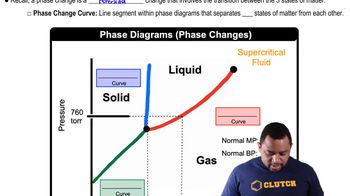Here are the essential concepts you must grasp in order to answer the question correctly.
Phase Transitions
Phase transitions refer to the changes in the state of matter, such as solid to liquid or liquid to gas, that occur due to variations in temperature or pressure. In this context, the compound transitions from solid to smectic liquid crystal at 121 °C and then to a fully liquid phase at 131 °C, illustrating how thermal energy influences molecular arrangement.
Recommended video:
Phase Changes in Diagrams
Liquid Crystal Phases
Liquid crystals are substances that exhibit properties between those of conventional liquids and solid crystals. The smectic phase, mentioned in the question, is characterized by layered structures where molecules are organized in planes but can flow like a liquid. Understanding these phases is crucial for interpreting the molecular arrangement at different temperatures.
Recommended video:
Phase Changes in Diagrams
Molecular Arrangement
Molecular arrangement refers to the specific organization of molecules within a substance, which affects its physical properties. At 135 °C, the compound is in a liquid phase, where molecules are more randomly arranged compared to the ordered structure of solids or the layered structure of liquid crystals. Analyzing the image helps identify the correct molecular arrangement at this temperature.
Recommended video:




